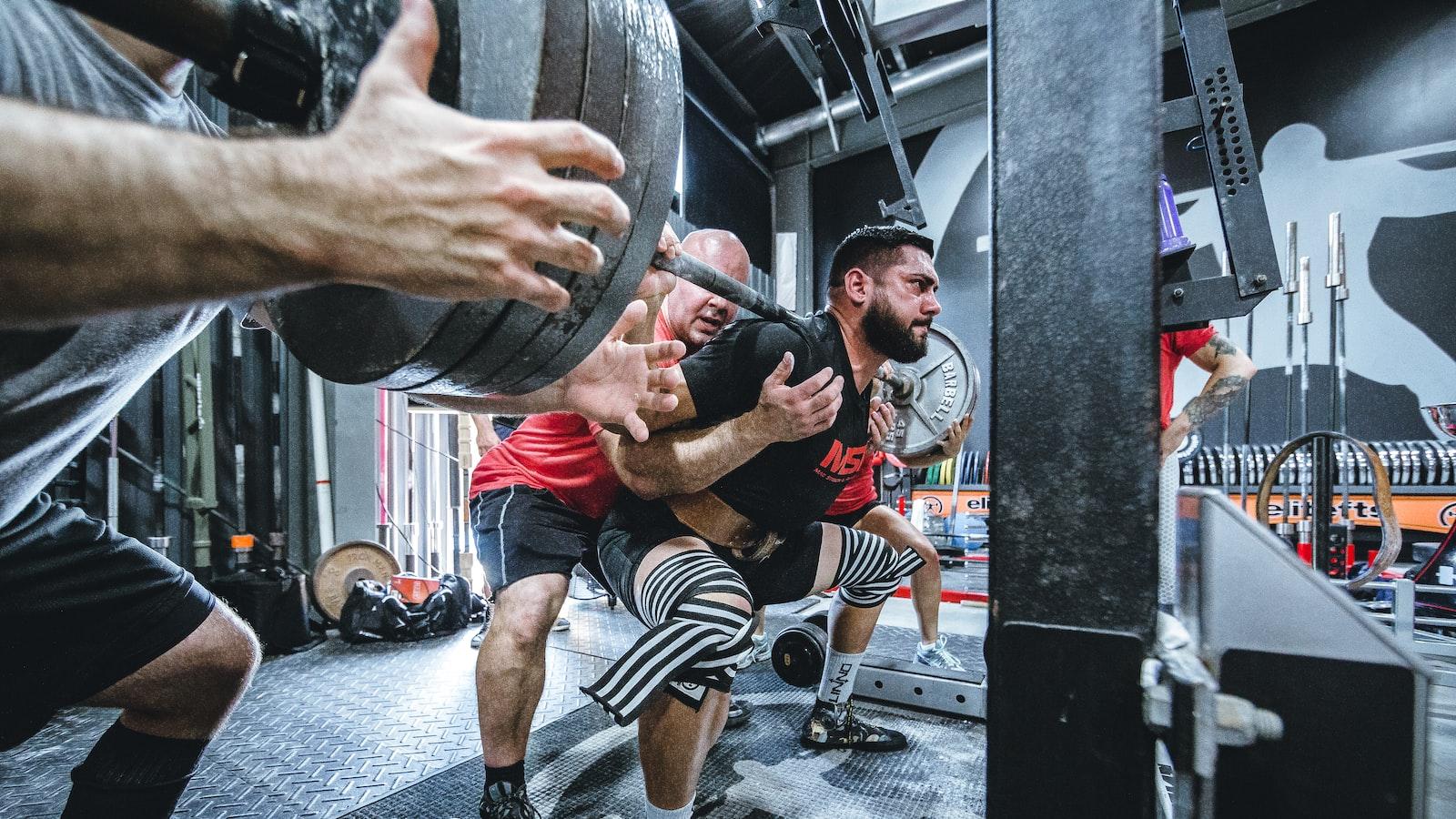
The bench press is a widely popular and effective exercise for building upper body strength. However, sometimes hitting a plateau or struggling with maintaining proper form can be frustrating. If you’re looking for a simple yet effective way to improve your bench press technique and maximize your gains, incorporating a resistance band into your training routine can be a game-changer. In this article, we will dive into the mechanics and benefits of using a band to enhance your bench press, providing you with step-by-step instructions and expert tips for a more efficient and productive workout. Whether you are a beginner or a seasoned lifter, this informative guide will help you harness the power of bands to elevate your bench press performance to new heights.
Benefits of Using a Band for Bench Press
Using a band to assist with your bench press can provide numerous benefits to your workout routine. Incorporating this simple piece of equipment into your training can help you target specific muscles, increase strength, and improve overall performance. Here are some key advantages of utilizing a band for bench press:
Increased resistance: Attaching a band to your bench press barbell adds levels of resistance throughout the entire range of motion. This constant tension challenges your muscles, forcing them to work harder and leading to greater strength gains over time. The band also adds a dynamic element to your workout as it resists both the concentric and eccentric phases of the lift.
Enhanced muscle activation: Using a band during bench press engages more muscle fibers, particularly in the chest, shoulders, and triceps. As the band stretches, it contracts these muscles even more, promoting better muscle activation and recruitment. This can result in improved muscle development, increased power output, and enhanced overall upper body strength.
Improved stability and control: By incorporating a band, you can boost your stability and control during the bench press movement. The bands provide tension that forces you to stabilize the weight, enhancing your core and shoulder stability. This helps you maintain proper form and technique, which is crucial for preventing injuries and maximizing your performance.
Variability and customization: Bands come in different strengths and thicknesses, allowing you to customize the level of assistance or resistance based on your fitness level and goals. Whether you’re a beginner looking for support or an advanced lifter seeking a challenge, bands offer fantastic versatility and adaptability to meet your specific needs. You can easily adjust the band tension by changing its placement on the barbell or by using multiple bands simultaneously.
Rehabilitation and injury prevention: Bands can be a valuable tool for those recovering from upper body injuries or aiming to prevent them. With the band providing assistance, you can gradually reintroduce the bench press exercise without placing excessive stress on the joints or muscles. This controlled yet challenging movement helps build strength, stability, and confidence, reducing the risk of reinjury and aiding in the rehabilitation process.
Incorporating a band into your bench press routine can take your workouts to the next level. With its ability to increase resistance, target specific muscles, improve stability, and cater to individual needs, it’s an efficient and effective tool for building strength and enhancing overall performance. Consider integrating bands into your training regimen and experience the benefits for yourself.

Proper Set Up and Positioning with the Band
<p>Using a band during bench press can provide additional resistance and help maximize your gains. However, it is crucial to set up and position the band correctly to ensure safety and effectiveness. Here are some tips to help you use a band to enhance your bench press workout:</p>
<h3>Choose the Right Resistance Band</h3>
<p>Not all bands are created equal when it comes to bench press assistance. Select a band that provides enough tension to challenge your muscles without compromising your form. Experiment with different bands and resistance levels to find the one that suits your fitness level and goals best.</p>
<h3>Secure the Band Properly</h3>
<p>Attach the band to a sturdy anchor point or wrap it securely around a fixed bar. Ensure the band is tightly secured to prevent slipping or snapping during the exercise. Using a band with handles can provide better grip and stability.</p>
<h3>Maintain Proper Technique</h3>
<p>Proper technique is essential when using a band for bench press assistance. Maintain a neutral spine, engage your core, and plant your feet firmly on the ground. Grip the bar at shoulder-width apart, with hands slightly wider than your shoulders, for optimal stability and control.</p>
<h3>Control the Band Tension</h3>
<p>Keep the band tension consistent throughout the entire range of motion. Avoid excessive tension at the bottom of the movement as it may cause the bar to bounce or lose control. Gradually increase the band tension as you progress, ensuring you can maintain proper form and control.</p>
<h3>Gradually Increase Intensity</h3>
<p>Start with lighter resistance bands and gradually increase the intensity as you build strength and confidence. Over time, you can opt for thicker or stronger bands to challenge your muscles further. Always prioritize safety and avoid overwhelming yourself with excessive resistance.</p>
<table class="wp-block-table">
<tr>
<th>Benefits of Using a Band</th>
<th>Considerations</th>
</tr>
<tr>
<td>Increased muscle activation</td>
<td>Avoid overstretching or using a band that is too strong for your level</td>
</tr>
<tr>
<td>Enhanced power and strength gains</td>
<td>Focus on maintaining proper form throughout the exercise</td>
</tr>
<tr>
<td>Improved stability and control</td>
<td>Gradually progress and challenge yourself without compromising safety</td>
</tr>
<tr>
<td>Added variety to your workout routine</td>
<td>Consult with a fitness professional if you have any concerns or limitations</td>
</tr>
</table>
Techniques for Incorporating the Band into the Bench Press
The bench press is a popular exercise for building upper body strength, but did you know that incorporating a resistance band can provide an added challenge and further enhance the benefits? In this article, we will explore various techniques for using a band to help optimize your bench press workout.
1. Band Around the Barbell
One simple way to incorporate the band into the bench press is by looping it around the barbell. Start by securing both ends of the band beneath the bench or by stepping on them with your feet. As you lower the barbell towards your chest, you’ll feel the band stretching, creating additional tension. This added resistance will engage your muscles even more, especially during the upward phase of the movement.
2. Band Around Your Back
Another technique involves wrapping the band around your back and anchoring it to the bench or a sturdy support. This method allows for increased activation of the stabilizing muscles in your shoulders and back, providing greater control during the bench press. The band will pull your body back towards the bench, encouraging proper form and reducing the risk of injury.
3. Band Assisted Reps
If you’re just starting out or looking to build strength gradually, band assisted reps can be an effective method. Place the resistance band around your back and loop it over the barbell. The band will assist you by providing an upward push as you push the barbell away from your chest. Over time, you can gradually decrease the level of assistance by using a lighter band or reducing the tension.
4. Band Resistance Training
In addition to the bench press, incorporating band resistance training into your routine can be highly beneficial. Resistance bands come in various levels of resistance, allowing you to gradually increase the challenge as you progress. Performing exercises like band chest flies, band push-ups, or band tricep extensions can further target and strengthen your chest and upper body muscles.
5. Progressive Overload with Bands
If you’re looking to continually challenge yourself and stimulate muscle growth, you can employ a technique called progressive overload with bands. This involves gradually increasing the tension or resistance of the band over time. By doing so, you’ll constantly push your muscles to adapt and grow stronger. Keep track of your progress and gradually increase the band’s resistance to continue making gains.

Progressive Resistance Training with Bands for Bench Press
When it comes to improving your bench press, utilizing progressive resistance training with bands can be a game-changer. Bands provide accommodating resistance, meaning that the tension increases as you reach the top of the lift, where you are traditionally strongest. This helps to build explosive power and strength throughout the entire range of motion. In this article, we will guide you through the ins and outs of incorporating bands into your bench press routine.
Step 1: Choosing the Right Bands
The first step in using bands for bench press is selecting the appropriate bands for your strength level. Bands come in various resistances, so it’s crucial to choose ones that challenge you without compromising your form. A general guideline is to pick bands that allow you to perform around 8 to 12 reps with proper technique and effort.
Step 2: Set Up the Bands
To set up the bands, secure one end of each band to the barbell and the other end to an anchor point like a power rack or dumbbell positioned at ground level. Ensure the bands are evenly spaced and properly secured. This setup will create tension as you lower the weight and increase it as you lift, giving you that added resistance throughout the exercise.
Step 3: Engage Proper Technique
When performing the bench press with bands, it is crucial to maintain proper technique. Ensure your grip is wide enough to allow the bands to stretch but not so wide that it compromises your shoulder stability. Remember to keep your back flat on the bench, core engaged, and feet planted firmly on the ground. Focus on driving through your heels and maintaining tension throughout your entire body as you press.
Step 4: Incorporate Progressive Overload
Progressive overload is the key to continual strength gains. Start with a lighter weight that you can comfortably handle while maintaining good form. As you progress, gradually increase the weight on the bar and adjust the tension in the bands accordingly. This will challenge your muscles and continue to stimulate growth and adaptation.

Safety Precautions and Common Mistakes with Band-assisted Bench Press
Using a resistance band to assist your bench press can be a game-changer, allowing you to progressively build up strength and break through plateaus. However, like with any exercise, it’s crucial to prioritize safety and avoid common mistakes that could lead to injuries or suboptimal results. Here are some safety precautions and common mistakes to keep in mind when using a band to help with your bench press.
Safety Precautions:
- Inspect the band: Before starting your workout, thoroughly inspect the resistance band for any signs of wear and tear, such as fraying or stretching. If the band is damaged, replace it to ensure your safety.
- Secure the band: Make sure the resistance band is securely fastened to the bench and barbell to prevent any unexpected movements or accidents during the exercise.
- Warm up properly: Always warm up your muscles before attempting the bench press with a band. This helps to increase blood flow and flexibility, reducing the risk of strains or pulls.
Common Mistakes:
- Using too much tension: One common mistake is using a band with too much tension, which can lead to poor form and unnecessary strain on your joints. Start with a lighter band and gradually increase the tension as your strength improves.
- Ignoring proper form: It’s essential to maintain proper form throughout the exercise. Avoid arching your back excessively or bouncing the bar off your chest. This can lead to back injuries or reduce the effectiveness of the exercise.
Proper Band Placement:
Correct band placement is crucial to maximize the benefits of the band-assisted bench press. Here’s a simple guide:
| Band Placement | Benefits |
|---|---|
| Band over the barbell, around your back, and held under your palms. | Helps create tension and assistance at the bottom of the lift. |
| Band looped around the uprights or bench pegs. | Provides additional assistance throughout the entire movement. |
Listen to Your Body:
Lastly, always listen to your body and adjust the band tension and resistance according to your ability. If you feel any sharp pain or discomfort, stop the exercise and consult with a fitness professional or healthcare provider.
Q&A
Q: What is a band and how can it assist with bench pressing?
A: A band, often referred to as a resistance band, is a versatile and elastic tool used in strength training exercises, including the bench press. When incorporated into this exercise, a band provides additional resistance, helping to enhance muscle activation and increase the overall effectiveness of the bench press.
Q: How does using a band during bench presses benefit the muscles?
A: Utilizing a band during bench press sessions helps target and engage the muscles involved in the pressing movement even more intensely. The additional resistance provided by the band increases the tension on the muscles throughout the entire range of motion. This helps promote muscle activation and development in areas such as the chest, shoulders, and triceps.
Q: Can anyone use resistance bands during bench press exercises?
A: Yes, resistance bands are suitable for almost everyone, regardless of fitness level or experience. Beginners and advanced lifters alike can take advantage of the benefits offered by bands when incorporated into their bench press routine. However, it is important to start with a band that provides appropriate resistance and gradually progress as your strength improves.
Q: How do I choose the right band for my bench press workouts?
A: When selecting a band, it is crucial to choose one that matches your current strength and fitness level. Bands come in varying levels of resistance, indicated by color or tension rating. Start with a lighter resistance band, and as you become accustomed to the movements and gain strength, gradually increase the band’s resistance to ensure progressive overload and continued muscle growth.
Q: How should I set up the band for bench press exercises?
A: To set up the band for bench press exercises, there are a few different methods you can try depending on your preferences. These commonly include wrapping the band around the barbell and securing it to the ground, attaching it to a power rack or sturdy anchor, or looping it around your back and gripping it with your hands.
Q: Are there any safety precautions I should consider when using a band during bench presses?
A: Yes, safety should always be a priority when using resistance bands during any exercise, including bench presses. Ensure that the band is securely anchored and properly wrapped around the bar or secure point. Additionally, always maintain control and proper form throughout the movement to minimize the risk of injury.
Q: Can I solely rely on using bands for bench press training or should I combine them with free weights?
A: While resistance bands can be an excellent addition to your bench press routine, it is generally recommended to combine them with free weights for optimal results. Free weights provide a stable and consistent load throughout the movement, while bands add extra resistance and challenge at different points in the bench press. Combining both methods can create a more well-rounded and effective training program.
Q: Are there any alternative exercises or variations using bands that can complement bench pressing?
A: Absolutely! In addition to bench presses, resistance bands offer various exercises and variations that can complement and further enhance your bench press routine. Some examples include band push-ups, band chest flies, and band tricep extensions. These exercises target similar muscle groups from different angles, providing a more comprehensive and balanced workout.
Q: Are there any specific training programs or guidelines to follow when using bands for bench presses?
A: While there aren’t any strict rules, it is recommended to gradually incorporate bands into your bench press routine. Begin by adding bands to specific sets or exercises, and gradually increase the frequency and intensity over time. Consulting with a qualified fitness professional or incorporating a structured training program can also be helpful in maximizing the benefits and preventing overuse injuries.
Q: What other equipment or accessories might be useful when using bands for bench presses?
A: Apart from resistance bands, there are a few additional accessories that may enhance your bench press training when using bands. These include sturdy anchors or power racks to secure the bands, weightlifting gloves or grip pads for optimal grip, and a training partner or spotter for added safety during heavy lifts. In conclusion, incorporating resistance bands into your bench press training can provide numerous benefits and enhance your overall strength and stability. By understanding the mechanics of the exercise and following a guided approach, you can effectively utilize bands to target different muscle groups, increase muscle activation, and develop better control of the movement.
Remember to start with light to moderate resistance bands and gradually progress as your strength improves. Focus on maintaining proper form and alignment throughout the exercise to minimize the risk of injury.
Additionally, always warm up adequately and listen to your body’s cues. If you experience any discomfort or pain during the exercise, it’s essential to consult with a qualified fitness professional or medical expert.
By incorporating bands into your bench press routine, you can take your training to the next level and achieve noticeable improvements in your strength and overall performance. So, go ahead, incorporate bands into your workouts, and witness the transformative effects they can offer. Unleash the power of the band, and strive for new personal bests in your bench press journey.






